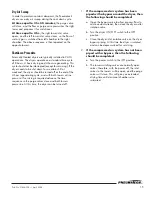
10
Pub. No. OM-A-10E — April 2004
3.
FAIL TO SHIFT:
The fail to shift inhibit will be
energized if the inhibit switch remains closed for 30
minutes beyond the normal cycle. Fail to shift will be
indicated by the red LED on the remote I/O module
and the fail to shift relay will be energized for remote
annunciation. The fail to shift inhibit is an indication
of a malfunction of the tower switching valves or
purge exhaust valves.
4.
PULSE PURGE REGENERATION (PPR) WITH
DEWPOINT DEMAND:
PE and EE series dryers
with optional Pulse Purge Regeneration (PPR) are
controlled by a Programmable Logic Controller (PLC)
instead of the standard DMP controller with Cycle
Sight™. PPR utilizes an 8 hour drying/regeneration
cycle but changes the purge cycle from continuous
purge to a 30-minute purge period. After the purge
period, the tower is pressurized with hot dry air for a
30-minute hold period. After the 30-minute hold
period, the dryer depressurizes and repeats the 30-
minute purge period. This cycle (PPR) repeats three
times followed by a 30-minute cooling period which
cools the desiccant bed to line temperature before the
towers switch. The PPR mode reduces the purge cycle
by 50% and significantly reduces heater run time. All
PPR functions are controlled by the PLC. If for any
reason the system should experience a deteriorating
dewpoint, the PLC will default to the standard cycle
until full performance recovery has been achieved.
When the system senses full recovery, it will
automatically switch to PPR mode. The default mode
ensures performance integrity. PPR is packaged with
Dewpoint Demand and High Humidity alarm for
maximum energy savings. The following hour meters
are provided to indicate savings: Heater Run Time,
Dryer Run Time, Demand Time.
Sequence of Operation
The sequence of operation of the External Heat
Reactivated Dryer can be readily followed by referring to
the following flow schematic and timing sequence.
During initial start-up with the power switch in the OFF
position, and the towers pressurized with air, both inlet
valves stay in the OPEN position (standard with models
PE-300 and larger) and the purge valves stay in the
CLOSED position. This type of fail safe valve operation
allows the air to dry through both the towers, without any
purge in the event of loss of power to dryer. This will give
you extended drying time until desiccant chambers are
saturated.
The desiccant is designed to handle air saturated with
water vapor only. Any liquids or slugs of water tend to
decrease the efficiency of the desiccant and retard the
regeneration process to provide the designed dewpoint.
With the power switch in the ON position at
time equal to 0.0 hrs.,
the left tower air inlet valve is
open to allow the air to pass through the left tower. The
right tower inlet valve is closed. The saturated compressed
air/gas passes through the desiccant in the left tower
where the desiccant adsorbs the moisture, and the dry air
at a pressure dewpoint of -40°F or less exits through the
left outlet check valve and goes out into the plant air
system through the afterfilter.
At time equal to 5 minutes,
the right lower purge
valve depressurizes the right tower so that the desiccant is
not disturbed (on high pressure dryers depressurization is
accomplished by a designated valve). At the same time
the heater is energized to commence the heating cycle.
NOTE:
As soon as the purge valve has opened, adjust the
purge adjustment valve to the recommended purge control
setting. This adjustment should only be required once, and
then the locking mechanism should be locked in place.
The temperature of the purge air is controlled by the
heater control thermostats to maintain the preset
temperature. The hot and dry purge air passes through the
right purge flow check valve and enters the desiccant bed
at the top of the tower and removes the previously
adsorbed water vapor from the desiccant and purges out
through the right purge valve, and is exhausted into the
atmosphere through the exhaust muffler.
NOTE:
During the regeneration air flow through the
desiccant bed, the tower pressure gauge should read 0
PSIG. Any higher pressure is an indication of a plugged
muffler, which will retard the regeneration of desiccant.
During the heating cycle, the bed temperature should rise
to 250°F (121°C) in approximately two hours. The heater
control thermostats will cycle the heater to maintain this
250°F bed temperature.
At time equal to 2 hr. 30 minutes,
the heater is de-
energized, and the cooling cycle begins to reduce the
temperature in the desiccant bed and prepare it for the
drying cycle.
At time equal to 3 hr. 50 minutes,
the right tower
purge valve will close. With this valve closed, the flow of
purge air repressurizes the right tower and prepares it for
switch-over.
At time equal to 4 hr.,
the right tower inlet valve
opens, and the left tower inlet valve closes, so the flow of
wet air/gas is switched from left chamber to the right
chamber.
At time equal to 4 hr. 5 minutes,
the left tower
purge valve opens and depressurizes the left tower. The
above sequence is then repeated on the opposite towers.













































